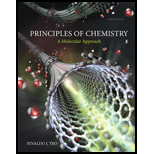
Concept explainers
(b)
Interpretation:
The molecular orbital (MO) energy diagram is to be drawn. The bond order in a molecule or ion with each number of total valence electrons is to be calculated. The magnetic nature of the molecules in terms of diamagnetic or paramagnetic is to be predicted.
Concept introduction: The molecular energy diagram is the representation of the energy levels in a molecule. Such representation plays a very important role in the
Bond order of any molecule is calculated with the help of MO diagram.
If all the electrons are paired in MO diagram then the molecule is diamagnetic in nature.
If any of the electrons is unpaired in MO diagram then the molecule is paramagnetic in nature.
Interpretation:
The molecular orbital (MO) energy diagram is to be drawn. The bond order in a molecule or ion with each number of total valence electrons is to be calculated. The magnetic nature of the molecules in terms of diamagnetic or paramagnetic is to be predicted.
Concept introduction: The molecular energy diagram is the representation of the energy levels in a molecule. Such representation plays a very important role in the chemical bonding of the atoms within the molecule. Electrons, filled in MO diagram follow certain rules.
Bond order of any molecule is calculated with the help of MO diagram.
If all the electrons are paired in MO diagram then the molecule is diamagnetic in nature.
If any of the electrons is unpaired in MO diagram then the molecule is paramagnetic in nature.
Interpretation:
The molecular orbital (MO) energy diagram is to be drawn. The bond order in a molecule or ion with each number of total valence electrons is to be calculated. The magnetic nature of the molecules in terms of diamagnetic or paramagnetic is to be predicted.
Concept introduction: The molecular energy diagram is the representation of the energy levels in a molecule. Such representation plays a very important role in the chemical bonding of the atoms within the molecule. Electrons, filled in MO diagram follow certain rules.
Bond order of any molecule is calculated with the help of MO diagram.
If all the electrons are paired in MO diagram then the molecule is diamagnetic in nature.
If any of the electrons is unpaired in MO diagram then the molecule is paramagnetic in nature.
Want to see the full answer?
Check out a sample textbook solution
Chapter 10 Solutions
Principles of Chemistry: A Molecular Approach (3rd Edition)
 ChemistryChemistryISBN:9781305957404Author:Steven S. Zumdahl, Susan A. Zumdahl, Donald J. DeCostePublisher:Cengage Learning
ChemistryChemistryISBN:9781305957404Author:Steven S. Zumdahl, Susan A. Zumdahl, Donald J. DeCostePublisher:Cengage Learning ChemistryChemistryISBN:9781259911156Author:Raymond Chang Dr., Jason Overby ProfessorPublisher:McGraw-Hill Education
ChemistryChemistryISBN:9781259911156Author:Raymond Chang Dr., Jason Overby ProfessorPublisher:McGraw-Hill Education Principles of Instrumental AnalysisChemistryISBN:9781305577213Author:Douglas A. Skoog, F. James Holler, Stanley R. CrouchPublisher:Cengage Learning
Principles of Instrumental AnalysisChemistryISBN:9781305577213Author:Douglas A. Skoog, F. James Holler, Stanley R. CrouchPublisher:Cengage Learning Organic ChemistryChemistryISBN:9780078021558Author:Janice Gorzynski Smith Dr.Publisher:McGraw-Hill Education
Organic ChemistryChemistryISBN:9780078021558Author:Janice Gorzynski Smith Dr.Publisher:McGraw-Hill Education Chemistry: Principles and ReactionsChemistryISBN:9781305079373Author:William L. Masterton, Cecile N. HurleyPublisher:Cengage Learning
Chemistry: Principles and ReactionsChemistryISBN:9781305079373Author:William L. Masterton, Cecile N. HurleyPublisher:Cengage Learning Elementary Principles of Chemical Processes, Bind...ChemistryISBN:9781118431221Author:Richard M. Felder, Ronald W. Rousseau, Lisa G. BullardPublisher:WILEY
Elementary Principles of Chemical Processes, Bind...ChemistryISBN:9781118431221Author:Richard M. Felder, Ronald W. Rousseau, Lisa G. BullardPublisher:WILEY





